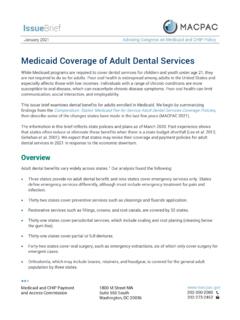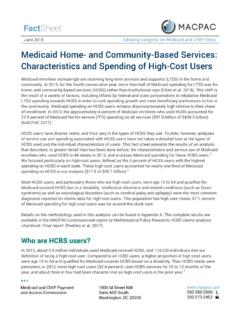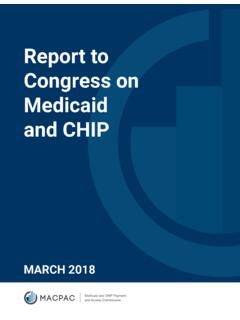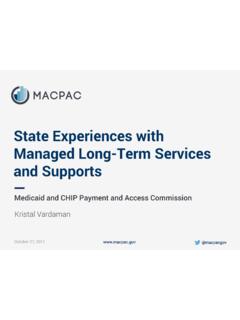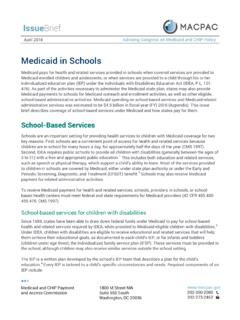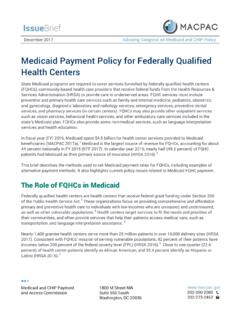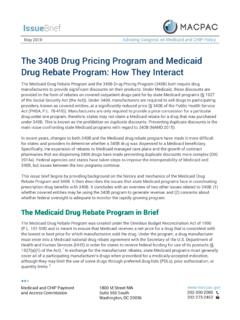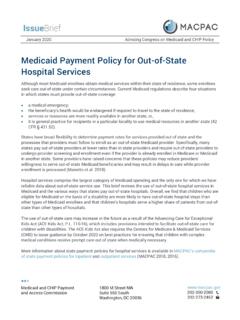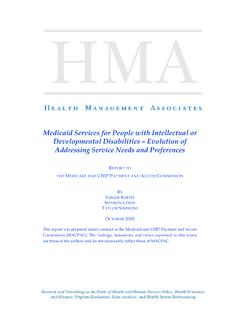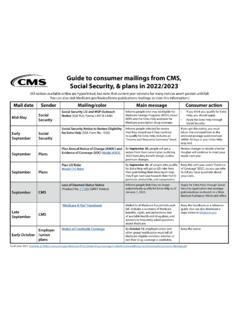Transcription of Medicaid and the Criminal Justice System - MACPAC
1 July 2018 Advising Congress on Medicaid and CHIP Policy Medicaid and the Criminal Justice System Medicaid and the Criminal Justice System share responsibility for providing health care to Justice -involved populations. With a few exceptions, Medicaid is the payer of health care services for eligible and enrolled individuals who are subject to parole and probation, while correctional institutions, including federal and state prisons and local jails, must pay for health care costs while individuals are confined to their facilities. Although inmates of public institutions can remain eligible for Medicaid in many states, federal law prohibits use of federal Medicaid funds for most health care services for inmates of public institutions except in cases of inpatient care lasting 24 hours or more. This issue brief describes how Medicaid and the State Children's Health Insurance Program (CHIP) interact with the Criminal Justice System .
2 We examine the roles of Medicaid and the correctional System in providing health care, including Medicaid eligibility and payment policies applicable to individuals who are inmates of a public institution. We also examine CHIP eligibility rules for Justice -involved youth. Finally, we highlight state efforts to enroll individuals in Medicaid and address the health care needs of the Justice - involved population. The Justice -Involved Population Criminal Justice -involved individuals include adults serving sentences in prisons and jails, awaiting trial or sentencing, and those under community supervision, such as parole or They also include youth who may be served in a separate System ; most youth are under community supervision through orders of probation and parole. Compared to the general population, those involved in the Criminal Justice System tend to have more complex and unmet health care needs.
3 Adult population At the end of 2015, an estimated million individuals were under the supervision of the adult correctional System , including million on probation or parole, and million under the custody of state or federal prisons or local jails (BJS 2016b). In addition, there were million admissions to jails in 2015. Men are most likely to be incarcerated. In 2015, 93 percent of individuals sentenced to federal and state prisons and percent of individuals in local jails were male (BJS 2016a, BJS 2016b). Black men are incarcerated at rates six times higher than the rate for white men and nearly two and half times higher than the rate for Hispanic men (McDaniel et al., 2013). Adults involved in the Criminal Justice System have a higher prevalence of HIV/AIDS, tuberculosis, sexually transmitted diseases, and hepatitis B and C than the general population (NCCHC 2002).
4 They also have higher rates of chronic conditions such as asthma, diabetes, and hypertension, as well as behavioral health 2. disorders. An estimated 65 percent of incarcerated individuals have a substance use disorder (CASA 2010, Greifinger 2007, James and Glaze 2006). Historically, most Justice -involved adults were uninsured. In expansion states, many are now eligible for Medicaid coverage upon release. For example, officials from New York and Colorado estimate that 80 and 90 percent of state prison inmates respectively, were likely eligible for Medicaid . In North Carolina, which has not expanded Medicaid , only 2 percent of state prison inmates are eligible for Medicaid at any given time (GAO 2014). Juvenile population Juveniles involved in the Criminal Justice System include those between the ages of 10 and 17 charged with a misdemeanor or felony, delinquency, or non- Criminal status offenses such as truancy and running Most juveniles are placed on community probation, and a small number are placed in residential treatment (NCJJ 2017).
5 Of those in residential placements, 87 percent are male and about two-thirds are minorities (Acoca, Stephens, and Van Vleet 2014). Many youth served in the juvenile Justice System are Medicaid or CHIP eligible, although this varies by state. A recent survey of seven states found Medicaid enrollment ranging from one-third of Justice - involved youths in one state to 60 percent in three states, to 100 percent in one state (Zemel and Kaye 2009). Justice -involved youth have high rates of tuberculosis, dental problems, and sexually transmitted infections such as HIV (Teplin et al. 2013). Approximately two-thirds of Justice -involved youths have a diagnosable mental health or substance use disorder (NCMHJJ 2015). However, fewer than half of juvenile correctional facilities provide mental health evaluations to all youths.
6 About half of youths in custody (53. percent) say they have personally met with a counselor at their current facility (Sedlak and McPherson 2010). Medicaid and CHIP Eligibility for Criminal Justice -Involved Individuals Medicaid eligibility is not affected by an individual's involvement with the Criminal Justice System . By contrast, children and pregnant women cannot be enrolled in CHIP if they are inmates of public institutions (42 USC 2110(b)(2)(A) and 2112(d)(2)(C)). Thus, if a CHIP-enrolled child or pregnant woman is confined to an institution, CHIP coverage is terminated. There are some cases, however, in which incarceration can affect Medicaid eligibility, including: Supplemental Security Income-based (SSI) eligibility. SSI payments are suspended while an individual is incarcerated. If the individual's confinement lasts for 12 consecutive months or longer, eligibility for SSI.
7 Benefits terminates. At the point of SSI eligibility termination, an individual who is eligible for Medicaid on the basis of SSI also becomes ineligible for Medicaid benefits. If an individual's SSI benefits are 3. terminated, it can take several months for benefits to be reinstated upon release. Similarly, if a new application and disability determination is required upon release, a decision about a person's disability may take anywhere from three to five months (SSA 2017). Low-income parent or caretaker relative eligibility. If an individual who is eligible for Medicaid through this eligibility pathway is incarcerated, he or she will no longer be considered the custodial parent or caretaker of a child, and will thus no longer be eligible for Medicaid coverage through this pathway. Change in household income.
8 An individual's incarceration may change family household size, as well as monthly household income. These changes can affect the entire family's eligibility for Medicaid and CHIP. Medicaid Financing for Services in Correctional Settings As mentioned above, federal law prohibits states from using federal Medicaid matching funds for health care services provided to adult and juvenile inmates of public institutions, except when the inmate is admitted to an off-site hospital or other qualifying facility for at least 24 hours (42 USC 1393d(a)(29)(A)). To be considered an inmate of a public institution, an individual must be held involuntarily by law enforcement authorities (CMS 2016).3 In 2015, the Centers for Medicare & Medicaid Services (CMS) issued guidance further clarifying when an individual is considered an inmate of a public institution.
9 Specifically, federal matching funds are available for individuals who are: on parole, probation, or released to the community pending trial;. living in a halfway house where individuals can exercise personal freedom;. voluntarily living in a public institution; or on home confinement. Federal financial participation is not available for individuals living in: state or federal prisons, local jails, or detention facilities;. federal residential reentry centers;. residential mental health and substance use disorder treatment facilities for incarcerated individuals;. or hospitals or nursing facilities that exclusively serve incarcerated individuals (CMS 2016). States have an incentive to enroll individuals in Medicaid to claim federal funds for hospital stays that are over 24 hours. New Jersey attributed a 20 percent reduction in the department of correction's hospitalization costs due to its efforts to enroll individuals in Medicaid .
10 Ohio saw a more dramatic decline, reducing hospital costs by more than half, and attributed the availability of Medicaid to the reduction in prison health spending (Pew 2017). However, the extent to which Medicaid is the payer of eligible hospital services varies by state. Some states do not have written policies regarding Medicaid enrollment for incarcerated individuals, and other states have inconsistent policies (McKee et al. 2015). 4. Policies to Coordinate Medicaid and Correctional Agencies With expansion of Medicaid to the new adult group under the Patient Protection and Affordable Care Act (ACA, , as amended), more incarcerated individuals became eligible for Medicaid , prompting some states to evaluate their policies and improve communication with state and local correctional partners.
